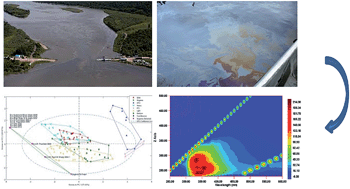Monitoring of polycyclic aromatic hydrocarbon contamination at four oil spill sites using fluorescence spectroscopy coupled with parallel factor-principal component analysis†
Abstract
Fluorescence spectroscopy analysis of oil and environmental samples collected from four oil spill incidents in Canada—a 2016 pipeline spill into the North Saskatchewan River (NSR), Saskatchewan; a 2015 train derailment in Gogama, Ontario; the 1970 sinking of the SS Arrow ship in Chedabucto Bay, Nova Scotia; and the 1970 sinking of the Irving Whale barge in the Gulf of St. Lawrence—permitted assessment of the PAH content of environmentally weathered samples. A recently developed fluorescence fingerprinting model based on excitation–emission matrix-parallel factor analysis-principal component analysis (EEM-PARAFAC-PCA) was applied to (i) evaluate the intensity of the abundant PAH groups in the samples, (ii) investigate changes in the PAH composition of environmental samples over time due to weathering, and (iii) classify the original spilled oil and environmental samples within the already established classes of the fingerprinting PCA model. The environmental sediment samples collected from the Husky Energy spill site show loss of PAHs occurring over the course of 15 months post-spill. However, the extent of weathering depends on several environmental factors rather than solely the time of weathering, the PAH loss was maximum at 15 months. There was a decrease in the PAH content of the environmental samples of Gogama spill collected 20 months post-spill. Almost all of Gogama environmental sediment samples underwent substantial weathering, making PCA classification impractical. The SS Arrow and Irving Whale samples fell within adjacent PCA groups, as they both had a similar type of spilled oil (Bunker C) with similarity in chemical composition.

- This article is part of the themed collection: ESPI Cover Art 2019


 Please wait while we load your content...
Please wait while we load your content...